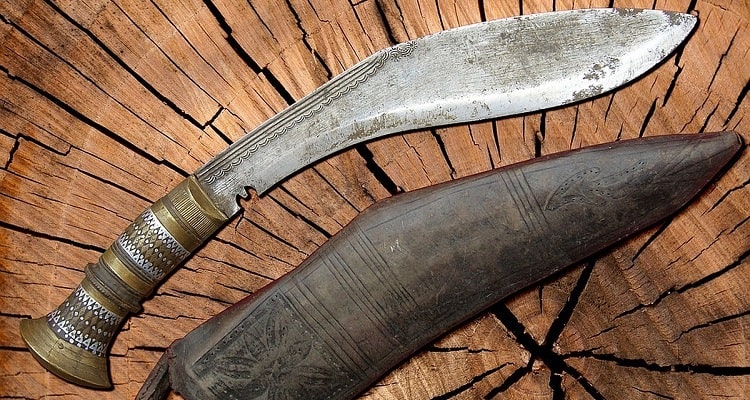
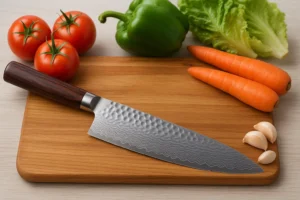

There are few knives with a richer history than the bold Kukri knife. Also known as the Khukuri, this traditional Nepalese weapon is known for its unique curved blade. The curve helps focus weight at the tip, making each swing more effective for cutting or chopping tough materials.
Survivalists and military personnel use the Kukri because of its efficiency and versatility. It also works as a great all-purpose cutting tool for serious adventurers.
The Kukri knife stands out because of its curved curved blade, heavy spine, and practical design. Its weight and craftsmanship make it a practical tool for chopping and cutting.
The curve lets you slice and chop with less effort. It gives the Kukri knife a sharp angle that makes both hacking and fine cutting easier. The thick spine adds strength, allowing you to cut through materials that would break thinner knives.
Some Kukris have grooves called chirras along the blade. These grooves reduce the blade’s weight and improve how it moves through the air when you swing it. The wide belly gives you more chopping surface than straight-edged knives. Many designs also have a notch near the handle that helps prevent chips from running up the edge.
Some versions known as Kukri machetes are used for clearing brush, showing how adaptable this blade design can be.
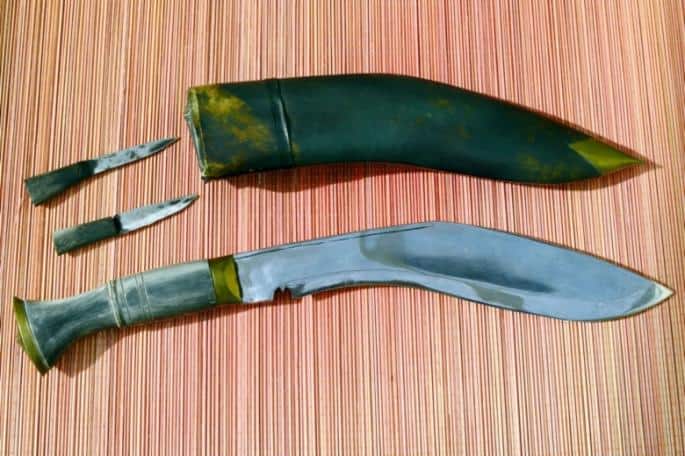
A Kukri is usually heavier than a regular knife because of its thick blade and solid spine. This extra weight is balanced toward the front of the blade. That forward-weighted design helps you generate powerful strikes without using much force, making chopping wood or other tough tasks easier on your wrist and arm.
The Kukri’s balance makes it feel almost like an ax when you swing it. This design allows you to cut deeply into wood or other materials with each swing. Even compared to larger machetes, the Kukri’s heavy blade often delivers more splitting power because its shape puts more force into every impact.
Some Kukris use full tang construction, meaning the metal of the blade extends through the handle. This makes the knife stronger and more durable for heavy use.
Skilled artisans often make traditional Kukri knives from high-carbon steel, which holds a sharp edge and resists breaking. They use methods passed down for generations to shape, harden, and polish each blade, giving the Kukri its reputation for quality. A high-carbon blade is critical for anyone relying on their Kukri for heavy-duty tasks.
The handle design is just as important as the blade. Most Kukris feature an ergonomic handle made from wood, horn, or sometimes metal. The design fits comfortably in your hand, letting you use the knife for long periods without slipping. Many traditional Kukris come with small utility knives called the Karda and sharpening tools called the Chakmak, which are stored in the same sheath as the main knife.
A Kukri crafted in this way blends durability, balance, and utility, making it useful and dependable for both daily work and survival needs.
The Kukri stands out because of its deep roots in Nepalese culture and its ongoing use in both daily life and military service. Its curved blade is more than a tool—it’s seen as a symbol of bravery, honor, and tradition in Nepal.
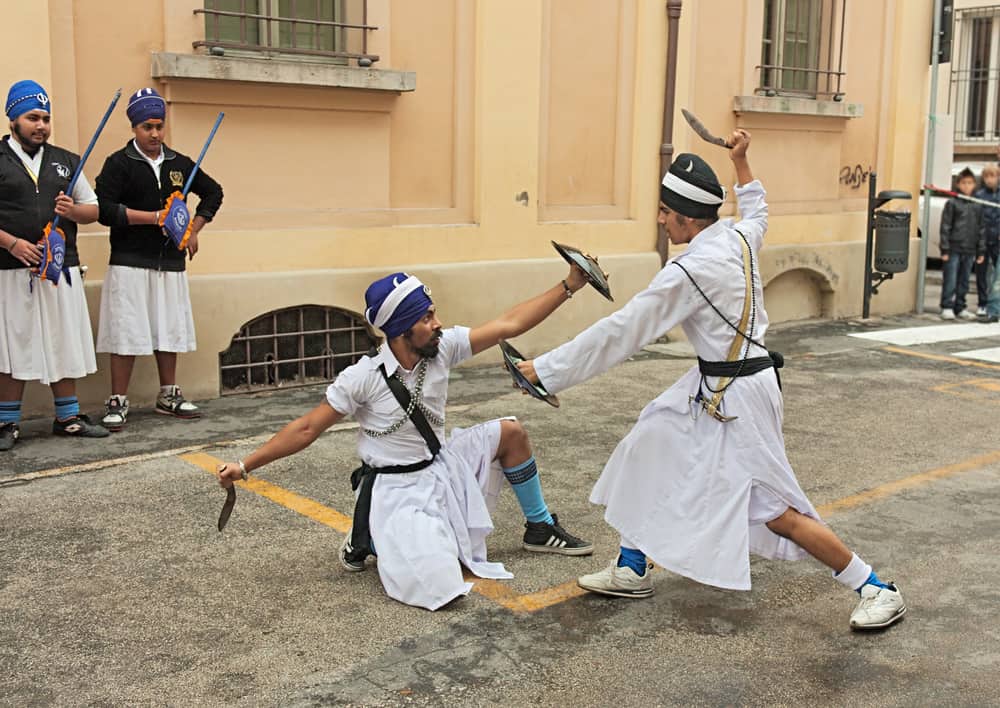
The Gurkhas are famous soldiers from Nepal. For these military personnel, the Kukri is more than just a combat weapon; it symbolizes courage and duty.
Gurkha soldiers have carried the Kukri into battle for over a century. The blade’s curved design makes it powerful and sharp enough for both offense and defense. Over time, the Kukri has become linked with the Gurkha’s reputation for bravery and skill.
Today, the Kukri remains a standard weapon for Nepalese Gurkhas in the army and is admired by military historians, collectors, and those interested in historical weapons. Authentic Kukris from the Gurkhas are treasured for their history and skilled craftsmanship.
The Kukri is a practical tool used by many people in Nepal for a wide range of tasks. Farmers use it for cutting crops, clearing brush, and chopping wood. Around the home, it works well for preparing food or as a utility tool for household tasks.
Its strong, curved blade makes it a favorite among outdoor enthusiasts, survivalists, and those interested in bushcraft or camping. When you go hiking or camping, a Kukri serves as a reliable survival knife for cutting branches, hunting, or building a shelter. Its versatility stands out compared to many other knives.
Collectors around the world appreciate the Kukri for its authentic design and historical significance. Survivalists consider it one of the best Kukri knives for outdoor activities because of the balance between strength, sharpness, and easy handling.
The Kukri is a powerful cultural artifact woven into Nepalese heritage. It’s much more than a functional tool—it carries spiritual and cultural significance as a symbol of bravery, honor, and tradition.
During important Nepalese festivals and ceremonies, the Kukri holds a special role. In the Dashain festival, the blade is often used in rituals and blessings, showing its importance in both religious and social events. These practices keep the Kukri’s place alive as a respected item in Nepalese culture.
Owning or gifting a Kukri is also seen as a form of respect and pride. For many families, passing down a Kukri from one generation to the next keeps the history and legacy of Nepal alive. Over time, it remains a symbol of both national and personal identity for many Nepalese people.

Since your Kukri knife is most likely made out of a steel-carbon alloy, it’s important that you regularly oil your blade. Use a light film of knife or motor oil to rehydrate the blade at least once a month, preferably after every time of use. This will help prevent rusting and keep your blade in excellent condition.
If you have a carved or serrated section of your Kukri knife, use some knife oil and toothbrush to gently scrape off any remaining particles.
In the event that rust develops, you can use a thin cloth, oil of your choice, and thin cut of sandpaper to help remove the rust. For best results, store your blade in a cool, dry area at all times to keep your blade in tip-top shape.
Before you put your Kukri knife up for display, ensure that it has been properly dried and oiled. Try to find an area that isn’t exposed to direct harsh light, as too much sun can alter blades negatively over time. Most importantly, keep the blade away from any and all moisture.
Kukri knives are also made commonly with steel alloys, which are easy to stain with fingerprints. Handle your knife with a soft glove or work gloves to prevent pesky prints from ruining your display.
The Kukri is well known for its inwardly curved blade, deep cultural roots, and practical uses in Nepal. Its build, history, and price can all help you understand its value and role.
A Kukri has a curved blade that bends sharply near its middle. Most blades range from 10 to 13 inches long and are made of high-carbon steel. The base of the blade often has a small notch called the “cho,” which can serve practical and symbolic purposes. The handle is commonly made of wood or horn and shaped for a firm grip.
The forward-curved blade shifts the weight toward the tip, making chopping easier and more powerful with less effort. This shape allows you to cut through wood, bone, or vegetation smoothly. The blade’s curve also lets you use it for precise slicing, hacking, and whittling tasks with control and efficiency.
The Kukri is a symbol of the Gurkha soldiers of Nepal, famous for their bravery in battle. It has been used for centuries as both a weapon and a tool. The Kukri is so closely linked to Nepalese warriors that it is often seen as a national symbol and carries deep respect among the people.
To check if a Kukri is authentic, look for traditional design features such as the forged high-carbon steel blade, the cho notch, and a handle made from natural materials. Genuine Kukris usually come with a scabbard made from wood and leather. Buying from trusted craftspeople or long-standing businesses in Nepal can help ensure authenticity.
In Nepal, the Kukri is used for daily chores like chopping wood, cutting meat, and preparing food. It is also an important tool for farming and clearing brush. Beyond practical work, it has strong ceremonial and cultural importance in both family and military settings.
Many makers handcraft quality Kukris, so the steel type, craftsmanship, and origin affect price and performance. Lower-priced Kukris may use cheaper materials or come from mass production. A good Kukri has a solid, full-tang blade, balanced weight, and a tight handle fit. Choose reputable sellers who provide clear information about materials and origin.
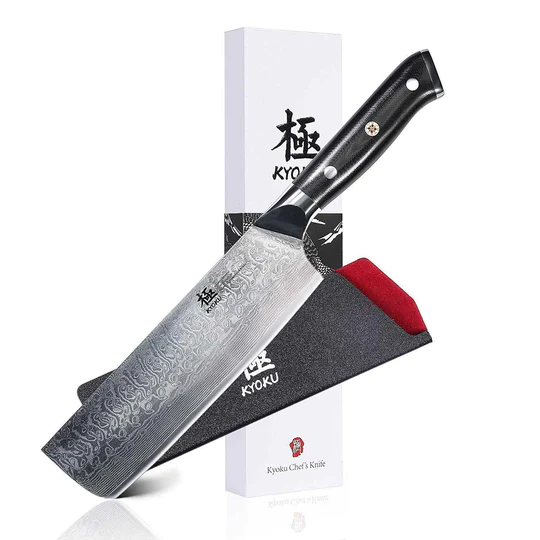
Knife Buzz offers independent product reviews on a wide range of knives used in the kitchen, home, and outdoors. We make it easy for you to find the right knife at the best price.

Knife Buzz offers independent product reviews on a wide range of knives used in the kitchen, home, outdoors and at work.
The Knife Buzz Team are passionate about reviewing knives and we cater to a targeted audience that needs independent advice before purchasing.
KnifeBuzz.com may earn affiliate commissions on some pages of this website. Knife Buzz is a participant in the Amazon Services LLC Associates Program, an affiliate advertising program designed to provide a means for sites to earn advertising fees by advertising and linking to Amazon.com. Amazon and the Amazon logo are trademarks of Amazon.com, Inc, or its affiliates. When you click links to various merchants on this site and make a purchase, this can result in this site earning a commission. Other affiliate programs and affiliations include, but are not limited to, Google AdSense.